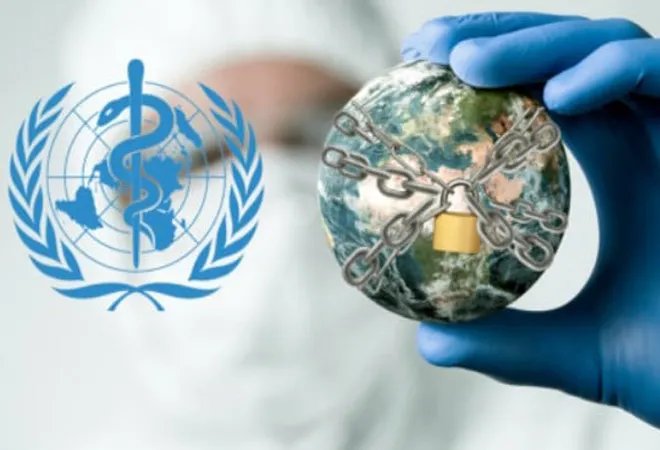
This article is part of the series—Raisina Edit 2023
We might be forgiven for not being more aware of the ongoing international negotiations about the so-called “pandemic treaty” given our collective pandemic fatigue, and the sheer number of national, regional, and global initiatives regarding the current COVID-19 pandemic as well as future ones. Despite the richest countries racing to declare the pandemic is over, it is still ongoing and continuing to produce devastating health, social, and economic consequences, particularly in low- and middle-income countries. Nevertheless, there are already global and multilateral initiatives aiming to address future pandemics, including The Pandemic Fund managed by the World Bank, Working Group on Amendments to the International Health Regulations (2005), the 100 Days Mission, the pandemic treaty, and more. It should surprise no one at this point that most of these efforts are located in rich countries and being driven by rich country civil servants, experts, and advocates. Moreover, given how the pandemic has resurfaced global North-South inequities, it should be worrying that the few but visible voices raising issues of global governance reform, health equity, ethics, and human rights are also largely based in Group of 7 (G7) countries, particularly the United States (US).
< style="color: #0069a6;">Among the diverse and uneven future pandemics efforts underway, the negotiations for a legally-binding instrument to govern all countries reflects both global political theatre as well as the limited mechanisms of the global governance system to motivate, guide, and enforce state actions.
Many of these future pandemic initiatives are inter-related, affirming the notion that global health emergencies require globally-coordinated efforts across numerous domains such as scientific research, financing, manufacturing and trade, international law, human rights/ethics, and so forth. Among the diverse and uneven future pandemics efforts underway, the negotiations for a legally-binding instrument to govern all countries reflects both global political theatre as well as the limited mechanisms of the global governance system to motivate, guide, and enforce state actions. More fundamentally, it is not clear if the most consequential lessons from the current pandemic have been widely recognised and accepted by global actors and are being reflected in the future pandemics discussions. If we are to believe a treaty would indeed realise global cooperation and compliance, how well are the needs of non-G7 countries, particularly the poorest countries, being reflected?
< style="color: #163449;">The pandemic treaty and its origins
According to the Council of Europe materials, an international treaty on pandemics was first proposed by its president Charles Michel at the Paris Peace Forum in November 2020. The idea was acknowledged and backed by the G7 and European Union leaders in early 2021. The locus of action then switched to the World Health Organisation (WHO), which established a Working Group of member states to consider various pandemic-related issues, and then organised a Special Session of the World Health Assembly (WHA) in late November 2021. By the end of the Special Meeting, a consensus was achieved that a new international legal instrument was needed for pandemic prevention, preparedness, and response in order that there is a “whole-of-government and whole-of-society approach, prioritising the need for equity.” Looking closely at the documents, it seems some member states wanted the instrument to also include other kinds of health emergencies as well as address medium- to long-term consequences.
< style="color: #0069a6;">The WHO set up an Intergovernmental Negotiating Body (INB), which was open to all member states and associate members, to draft and negotiate a “WHO convention, agreement or other international instrument on pandemic prevention, preparedness and response” (pandemic treaty).
As instructed, the WHO set up an Intergovernmental Negotiating Body (INB), which was open to all member states and associate members, to draft and negotiate a “WHO convention, agreement or other international instrument on pandemic prevention, preparedness and response” (pandemic treaty). Throughout 2022, the WHO held various consultations, public hearings, and INB meetings with remarkable transparency by making them all available online. As instructed by the Special Session, the period of drafting and negotiating the instrument will be rapid, with an expected draft by May 2024 when the WHA meets. That means that 2023 will be the year where idealistic rhetoric and inclusive information-gathering efforts will move into the realm of realpolitik and excruciating negotiations over words. A “Conceptual zero draft” was publicly released in December 2022.
< style="color: #163449;">The negotiating process
So, what is the scope and what is at stake in the pandemic treaty? Firstly, a new international instrument was initially supported and pursued by the 2021 WHA because the existing international legal instruments, procedures, and norms were recognised as having been inadequate in helping countries and the global system to respond quickly, effectively, or fairly to the COVID-19 pandemic. The main focus has been on the inadequacies of the International Health Regulations (IHR), which are meant to guide government actions when infectious diseases spread across borders. The IHR were first adopted in 1969 and focused on only six infectious diseases. They have been revised numerous times to eventually cover almost all trans-border public health risks (biological, chemical, radiological, etc). The last revision was in 2005, and expressly focused on state obligations to notify the WHO about a wide range of events within a specific period of time. What looks confusing and chaotic is that the recent WHA has now created two Working Groups. One group is to work on revisions to the IHR to reflect urgent issues raised by the COVID-19 pandemic, and a second group to draft a pandemic treaty. Both groups are to present their draft documents to the WHA in May 2024.
< style="color: #0069a6;">The IHR were first adopted in 1969 and focused on only six infectious diseases. They have been revised numerous times to eventually cover almost all trans-border public health risks (biological, chemical, radiological, etc).
Clearly, there is great overlap in subjects of the two groups, and many countries just do not have the diplomatic resources to manage multiple processes. Some commentators have noted that the IHR are technical and operational in nature while the pandemic treaty is different as it is much more “political,” addressing issues such as international assistance, access to technologies, and global equity. Another way to understand this duplication is that, now that the WHA and global health have become politically charged, and national leaders now recognise that health determinants and economic security are inter-linked, having two opportunities to press your country’s interests is better than just one. However, the US seems to have contained the scope of IHR revisions by fostering an agreement at the WHA 2022 that the IHR working group should pursue only a targeted set of technical amendments. The WHA meeting in May 2023 will be an important moment to see if that containment manoeuvre will survive. Putting aside the IHR, the scope of the draft pandemic treaty stretches from addressing the inadequacies of the IHR and the current global governance system to an aspiration for a whole-of-government and whole-society approach centred on equity. As is typical of UN documents and instruments, the draft recognises numerous and often conflicting ethical principles and other concepts such as state sovereignty, global cooperation, equal value of every life, the human right to health of every human being, interdependent vulnerabilities across borders, evidence-based decisions, one health, etc. The substantive core of the instrument is about sharing of pathogens and related benefits; global supply chains and logistics of pandemic response products; strengthening health systems; the role of the WHO; public health systems and literacy; sustainable financing of relevant resources; and, most importantly, levels of accountability for pandemic prevention, preparedness, and responses; and recovery of health systems and societies more broadly.
< style="color: #0069a6;">The most important invisible issues are global equity and human rights; most of the human beings negatively affected by pandemics live in low- and middle-income countries.
During 2023, the draft treaty will evolve, particularly at the WHA meeting in May, the many meetings of the INB and sub-INB drafting group, and due to other interventions by non-government actors and networks. What is notable is that while the conceptual draft has identified an expansive set of principles, concepts, and topics, it is far away from any substantive articulation of specific rights and duties of states, how these may differ according to the capacities of different states. More fundamental questions are left ignored such as what qualifies as a pandemic, and when does it start or end? Or who should have the authority to declare the start and end of a pandemic? Perhaps, the most important invisible issues are global equity and human rights; most of the human beings negatively affected by pandemics live in low- and middle-income countries. Whether representatives of such countries are motivated and capable of reflecting their people’s needs and interests in the treaty is unclear. The meagre space given to civil society to constructively engage in these negotiation processes makes it even harder for such concerns to be addressed. However, at the WHA 2022, some of these countries showed that they can paralyse the assembly when they really disagree. Perhaps, this new-found confidence of some non-G7 countries in the WHA will spread to others and carry through into the 2023 pandemic treaty negotiations.
The views expressed above belong to the author(s). ORF research and analyses now available on Telegram! Click here to access our curated content — blogs, longforms and interviews.




 PREV
PREV


